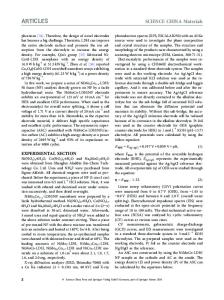Triazine-based 2D covalent organic framework-derived nitrogen-doped porous carbon for supercapacitor electrode
- PDF / 1,298,128 Bytes
- 8 Pages / 595.276 x 790.866 pts Page_size
- 39 Downloads / 352 Views
Carbon Letters https://doi.org/10.1007/s42823-020-00190-6
ORIGINAL ARTICLE
Triazine‑based 2D covalent organic framework‑derived nitrogen‑doped porous carbon for supercapacitor electrode Stella Vargheese1 · Muthu Dinesh1 · K. V. Kavya1 · Dhanaprabhu Pattappan1 · Ramasamy Thangavelu Rajendra Kumar1 · Yuvaraj Haldorai1 Received: 21 April 2020 / Revised: 12 September 2020 / Accepted: 19 September 2020 © Korean Carbon Society 2020
Abstract Doped porous carbon materials have attracted great interest owing to their excellent electrochemical performance toward energy storage applications. In this report, we described the synthesis of nitrogen-doped porous carbon (N-PC) via carbonization of a triazine-based covalent organic framework (COF) synthesized by Friedel–Crafts reaction. The as-synthesized COF and N-PC were confirmed by X-ray diffraction. The N-PC exhibited many merits including high surface area (711 m2 g−1), porosity, uniform pore size, and surface wettability due to the heteroatom-containing lone pair of electron. The N-PC showed a high specific capacitance of 112 F g−1 at a current density of 1.0 A g−1 and excellent cyclic stability with 10.6% capacitance loss after 5000 cycles at a current density of 2.0 A g−1. These results revealed that the COF materials are desirable for future research on energy storage devices. Keywords Covalent organic framework · Heteroatom-doped carbon · Porous materials · High surface area · Energy storage and conversion
1 Introduction Electrochemical energy storage has attracted increasing interest owing to the ever-rising demand for alleviating urgent energy and environmental issues. Among the different energy storage devices, supercapacitors are promising candidates [1]. Supercapacitors are energy storage and power supply devices that are developed to meet the increasing demand for applications in powering vehicles and portable electronic devices [1]. The supercapacitor possesses high power density compared to the battery and high energy density than the conventional capacitor [2]. Predominantly, the supercapacitor is classified into two types based on its different charge storage mechanisms, which are named as an electrochemical double-layer capacitor (EDLC) and pseudocapacitor [3]. In EDLC, the energy is stored in the form of charges at the electrode/electrolyte interface [4]. Carbon materials such as activated carbon, graphene, carbon nanotube, and porous carbon have been considered as potential * Yuvaraj Haldorai [email protected] 1
Department of Nanoscience and Technology, Bharathiar University, Coimbatore, Tamilnadu 641046, India
electrode materials for EDLC owing to their high surface area, high conductivity, excellent thermal stability, and good mechanical strength [5]. As electrode materials, activated carbon has been intensively studied with capacitances up to 270 F g−1 [6]. Recently, nanostructured carbon materials such as templated carbon materials, graphene, carbon nanotubes, aerogels, and heteroatom-doped carbon materials have been developed to improve th
Data Loading...











